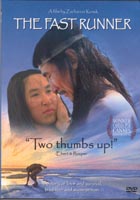
2001

The Fast Runner
Inuit/Eskimo
Thought to be the only people in the world in which language, culture and physical type coincide.
There are a number of names for these people. The term “Eskimo” means “raw meat eaters” in Abnaki and Cree (Algonkin). There is a lack of any tribal structure among any of the bands, and a variety of terms have been used for the different groups as they adapted to local environments.
Some are geographical names: Greenland Eskimo, Labrador Eskimo, Central Eskimo, MacKenzie, Bering Strait and so on. Occasionally one find terms like Caribou Eskimo (those who hent caribou) or Copper Eskimo (those that used unsmelted copper – hammered) and so on. Rasmussen described some of the Central Eskimo as Netsilik and Iglulik.
Inuit is an Eskimo term meaning “humans”, while “-muit” is used to mean “the people of….”. The people along the Kuk River call themselves Kugmiut, although both these forms have slightly different variants in different Eskimo dialects. In addition, there are others called Aleuts, who live in a string of islands off the Alaskan Coast.
The land is relatively inhospitable and cooperation is a requirement. There is a need to keep friction down and in the absence of any “governmental structure” ways needed to be found. Leadership generally meant the ability to organize hunts rather than to compel action.
Characteristics of the Eskimo are song contests which in the west were a former of banter between men who were not related by kin ties (the most crucial aspect of the society). In the East these song duels which acted as a form of social control.
Food is very important because of the difficulty in getting it, Nanook, of the famous 1922 documentary died of starvation the year after the film was made. Hence there is a string involvement with food and food sharing on the part of most of the people.
Religion is shamanistic. Shaman are individual religious practitioners who work with supernaturals in magical dealings.
Watch for some of these things in the film.
The film has a number of problems for some viewers:
What is happening in the first set of scenes?
To some degree the film has to be seen as a supernatural film.
Song contests have people sing songs to "accuse" or deal with offenses. Aggression is often ritually controlled (songs, "boxing bout") Inuit marriages typically are complex with them being partially arranged but with some polygyny (having many wives) (COMPARE polygamy (having many spouses - general term; polyandry - having many husbands) and wife “swapping” and people leaving. Depending on how much support you can get from your family and friends will determine how successful this is. How do these themes manifest themselves in the film?
Eskimo have strong emotional attachment to children. Children are valued. How is this manifest in the fiml
Opening shots establish the open barreness of the land indicating both its spectacular nature and extreme isolation. The Eskimo have extremely low population densities.
Notice the transitions when Atanajuat and Atuat run on the ice and then the immediate next shot has Oki talking about the situation and Atanajuat is there.
How are the shifts in time handled? The two brothers as children are replaced by their older selves and then comment on the dialog of the scene just seen.
Changes in season are noted by changes in clothing and changes in flora and fauna.
Remember Adair/Worth work with the Navajo and the comment that Navajo students showed people walking a great deal of teh time. How much of the time do we see people walking? dealing with food?
HOW DOES THIS FILM DIFFER FROM THE FILMS SEEN PREVIOUSLY THIS TERM?
No identity problems, no problems of contact etc. The film has much more to do with universal themes than with individual problems of acculturation and culture contact.
Film deals with the impact of evil, not just on individuals but the group. The resolution to the film has to deal with a group reaction to the problem (the expulsion of Oki and his followers) in order to re-setablish some kind of social harmony.